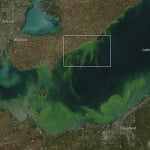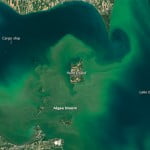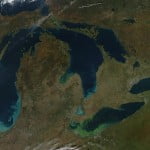- Home
- Health Topics
- Health Hazards
- Blue-Green Algae and Harmful Algal Blooms (HABs)
Blue-Green Algae and Harmful Algal Blooms (HABs)
What are blue-green algae?
Health EffectsExposure to blue-green algae toxins can cause the following health effects in people: Skin Contact (e.g. swimming or bathing in contaminated water)
Swallowed (e.g. eating contaminated fish or drinking contaminated water)
Dialysis water contaminated with these toxins can result in life-threatening liver damage. |
Also known as cyanobacteria, blue-green algae are bacteria that share features of both bacteria and algae. In a typical summer, lake water can contain several species of cyanobacteria. Ponds, streams and rivers can also contain this naturally occurring organism. Unfortunately, many types of cyanobacteria will release toxins when they die or are damaged that can cause illness and/or irritation in humans, pets and livestock. In the right conditions, these organisms can form a large mass called a bloom, also referred to as a Harmful Algal Bloom (HAB).
How harmful are cyanobacterial toxins?
Presence of an algal bloom does not necessarily mean toxins are present in the water at a concentration that is harmful to your health. Toxin concentrations can vary over time and locations. Even different strains within the same species of cyanobacteria have be found to produce varying toxin concentrations. However, because past studies have indicated that an average of 60% of blooms investigated have been positive for cyanobacterial toxins, any bloom encountered should be treated as potentially toxic unless laboratory analysis proves otherwise. Testing for levels of microsystin in the water, a cyanobacterial toxin, provides an indication of the risk in using the water for drinking, cooking, brushing teeth, bathing/showering, swimming and other recreational uses.
| Microcystin Levels | Drinking Water (also including cooking and bathing) | Recreational Water Use (e.g. swimming) |
|---|---|---|
| 0 to <1.5 ppb* | Safe for use. | Safe for use. |
| 1.5 to <20 ppb | Do not use this water for drinking, cooking, brushing your teeth, bathing or showering.
Do not allow pets or livestock to consume this water. |
Use with caution. Rinse off with uncontaminated water after use. |
| ≥20 ppb** | Do not use this water for drinking, cooking, brushing your teeth, bathing or showering.
Do not allow pets or livestock to consume this water. |
Do not use this water for swimming or other recreational uses.
Do not allow pets or livestock to enter or drink this water. |
| Toxic levels of microcystins can build up in fish. Avoid eating fish caught from waters experiencing a HAB and for up to two weeks after the bloom has disappeared.*** | ||
*As per the Ontario Drinking Water Standards (MOECC, 2006)
**As per the Guidelines for Canadian Recreational Water Quality (Health Canada, 2012)
***As per the Guide to Eating Ontario Fish (MOECC, 2015)
Note: Confirmation of toxins and toxin levels within a bloom cannot be accomplished by visual inspections so samples must be sent to a lab for analysis.
Toxins from blue-green algae cannot be removed by boiling the water or treating it with chlorine or UV light.
What does a Harmful Algal Bloom (HAB) look like?
HABs can vary in colour and texture. They can also move up or down through the water column over the course of the day and appear on the surface of the water or below the surface of the water.
To spot a Harmful Algal Bloom, look for water that:
- Resembles spilt paint
- Is discoloured or has streaks of colour. Most HABs in Lake Erie appear greenish (e.g. green, olive-green, bright green, blue-green) or sometimes black but could also be blue, brown, white, black, red or purple in colour.
- Looks slimy or woolly
- Has mats, scums or films on the surface
- Has clumps or globs floating below the surface
Note: Cyanobacterial scums can often be confused with small, harmless aquatic plants called duckweeds. Other true algal blooms that do not contain toxins can also form, but are considered a nuisance and not a public health hazard.
|
If you spot a Harmful Algal Bloom call the Ministry of Environment and Climate Change’s Spills Action Centre at 1-800-268-6060. |
|
| If you spot a HAB near you: | If you spot a HAB near your private water supply (e.g. intake from lake): |
|---|---|
|
|
| Persons served by a municipal drinking water system will be notified by the County and/or Haldimand-Norfolk Health Unit if their water has been impacted and precautionary measures are required. Routine water testing is done by the municipal water treatment plant and advisories are based on test results. | |
What causes a Harmful Algal Bloom to form?
Some sources of phosphorus and nitrogen include:
Note: Currently, the factor determining most of the algae growth in Lake Erie is phosphorus. |
The formation of a HAB requires the right environmental factors for the cyanobacteria to grow combined with a sudden change in weather conditions. Factors that contribute HABs include:
- Excess nutrients (phosphorus and nitrogen),
- Sunlight,
- Warmer temperatures (ideally >25°C),
- Calmer water with less wind and less flow,
- Selective grazing by zooplankton and zebra mussels that may avoid eating cyanobacteria, and
- Low salinity
When these conditions are combined with a sudden change in lake conditions from moderate winds with regular water circulation to no winds and calm water, cyanobacteria may become ‘overbouyant’ and float to the surface where they produce a scum. This scum may later drift towards shorelines where the cyanobacteria may eventually die and release their toxins.
What precautions should I take to prevent being exposed to HAB toxins?
| Ensure pets and livestock do not drink or are exposed to water contaminated by a HAB. Animals may appear weak, stagger, vomit, have convulsions and/or difficulty breathing if exposed to the toxins. There have been some instances where animals have died from such exposure. Seek veterinary assistance if the animal becomes ill. |
- Unless toxin levels are tested and found to be with acceptable limits (see above), do not use water contaminated by a HAB for:
- Drinking
- Cooking
- Brushing teeth
- Showering
- Bathing
- Swimming
- Fishing
- Other recreational activities
- Do not boil water, use chemical disinfectants (e.g. chlorine) or treat the water with UV to remove toxins. Such methods can actually increase toxin levels by killing the cyanobacteria. Remember, cyanobacteria release more toxins when damaged or dying.
- Ensure you regularly monitor the source of your water for HABs if you own a private drinking water system (i.e. you’re not on a municipal system) that takes water from a surface water such as a lake, pond, river or stream. Visual observation around your system’s intake can help determine if an alternative source should be used and/or if you should test your water for cyanobacterial toxins using a private lab.
- Do not eat fish caught from waters experiencing a HAB and for up to two weeks after the bloom has disappeared as the toxins have been found to accumulate in fish.
Locally, HABs are more likely to occur in late summer and early fall. However, under the right conditions, blooms can occur as early as spring and even under ice if enough sunlight is transmitted.
Doing Your Part to Prevent Harmful Algal Blooms
The following measures can help reduce excess nutrients of phosphorous and nitrogen from getting into our waters and contributing to the formation of HABs:
- Use a phosphorous-free fertilizer.
- Do not over-fertilize or over-water after applying fertilizer.
- Use phosphate-free detergents, personal care and household cleaning products.
- Check and maintain your private septic system regularly. Leaking septic systems can contribute to excessive nutrient loading in nearby waters.
- Do not modify drainage ditches in a way that will reduce the amount of natural filtration through the soil and vegetation (i.e. buffer zone) before the water enters the ditch.
- Prevent surface runoff from agricultural and livestock runoff.
- Maintain wetlands, marshes as well as native plants along shorelines and watersheds. They all help filter excess nutrients naturally.
- The burning of fossil fuels contributes to excess nitrogen being released into the air that then makes its way into our waters in the form of rain or snow. Reducing your consumption of fossil fuels will also help beyond reducing the contributing sources of HABs.
- If you own a pond experiencing HABs, consider installing a bottom aeration system. These systems help reduce the amount of phosphorous in a pond that contributes to HABs.
Photo credit NASA




